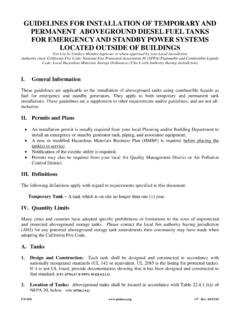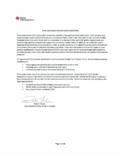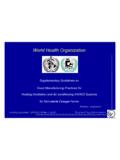Transcription of Annex 3 WHO good manufacturing practices for ...
1 World Health Organization WHO Technical Report Series, No. 957, 2010. Annex 3. WHO good manufacturing practices for pharmaceutical products containing hazardous substances 1. Introduction 2. General 3. Glossary 4. Risk assessment 5. Product protection 6. Personal protection equipment and breathing air systems 7. Environmental protection 8. Facility layout 9. Air-handling systems 10. Air-handling units 11. Safe change lter housings 12. Personnel decontamination systems 13. Ef uent treatment 14. Maintenance 15. Quali cation and validation References 192. 1. Introduction These guidelines set out good practices applicable to facilities handling pharmaceutical products (including active pharmaceutical ingredients (APIs)) that contain hazardous substances such as certain hormones, steroids or cytotoxins. They do not replace national legislation for protection of the environment and personnel.
2 Other WHO guides to good manufacturing practices (GMP) and regulations need to be observed in addition to the workers' safety criteria (1 4). These guidelines are to be read in conjunction with other WHO GMP. guidelines with respect to building nishes and general services installations, among others. See the reference list for relevant publications which serve as additional background material. The primary focus of these guidelines is on the air-conditioning and ventilation systems of the facility; however, the document also provides some guidance on personnel protection. The areas to which this document applies include all zones where the handling of products could lead to cross-contamination, exposure of personnel, or discharge to the environment. This includes research and development facilities, and the sites of API manufacturing and storage and of nished product manufacturing .
3 Where possible products should be manufactured in closed systems. 2. General Facilities should be designed and operated in accordance with the main GMP principles, as follows: to ensure quality of product;. to protect the operators from possible harmful effects of products containing hazardous substances; and to protect the environment from contamination and thereby protect the public from possible harmful effects of products containing hazardous substances. The production of certain products containing hazardous substances should generally be conducted in separate, dedicated, self-contained facilities. These self-contained facilities may be in the same building as another facility but should be separated by a physical barrier and have, separate entrances, staff facilities and air-handling systems. The extent of the separation from adjacent facilities and sharing of common services should be determined by risk assessment.
4 193. In general these manufacturing facilities should be regarded as containment facilities. The effective operation of a facility may require the combination of some or all of the following aspects: appropriate facility design and layout, with the emphasis on safely containing the materials being handled. manufacturing processes using closed systems or barrier technology enhance operator and product protection;. manufacturing process controls including adherence to standard operating procedures (SOPs);. appropriately designed environmental control systems (ECS) or heating, ventilation and air-conditioning (HVAC);. extraction systems;. personal protective equipment (PPE);. appropriate degowning and decontamination procedures;. industrial hygiene (monitoring staff exposure levels);. medical surveillance (monitoring staff exposure levels); and administrative controls. 3. Glossary The de nitions given below apply to terms used in these guidelines.
5 They may have a different meaning in other contexts. action limit The action limit is reached when the acceptance criteria of a critical parameter have been exceeded. Results outside these limits will require speci ed action and investigation. active pharmaceutical ingredient (API). Any substance or mixture of substances intended to be used in the manufacture of a pharmaceutical dosage form and that, when so used, becomes an active ingredient of that pharmaceutical dosage form. Such substances are intended to furnish pharmacological activity or other direct effect in the diagnosis, cure, mitigation, treatment or prevention of disease or to affect the structure and function of the body. air-handling unit (AHU). The air-handling unit serves to condition the air and provide the required air movement within a facility. airlock An enclosed space with two or more doors, which is interposed between two or more rooms, of differing classes of cleanliness, for the purpose of 194.
6 Controlling the air ow between those rooms when they need to be entered. An airlock is designed for and used by either people or goods (this can be a personnel airlock (PAL) or a material airlock (MAL)). alert limit The alert limit is reached when the normal operating range of a critical parameter has been exceeded, indicating that corrective measures may need to be taken to prevent the action limit being reached. barrier technology A system designed to segregate people from the product, contain contaminants or segregate two areas, which could be a barrier isolator (BI). or a restricted access barrier system (RABS): A BI is a unit supplied with high-ef ciency particulate air (HEPA) ltered air that provides uncompromised continuous isolation of its interior from the external environment, including surrounding clean room air and personnel. A RABS is a type of barrier system that reduces or eliminates interventions into the critical zone.
7 In practice, its level of contamination control is less than that of a barrier isolator. clean room A room or area with de ned environmental control of particulate and microbial contamination, constructed and used in such a way as to reduce the introduction, generation and retention of contaminants within the area. commissioning Commissioning is the documented process of verifying that the equipment and systems are installed according to speci cations, placing the equipment into active service and verifying its proper action. Commissioning takes place at the conclusion of project construction but prior to validation. containment A process or device to contain product, dust or contaminants in one zone, preventing it from escaping to another zone. contamination The undesired introduction of impurities of a chemical or microbial nature, or of foreign matter, into or on to a starting material or intermediate, during production, sampling, packaging or repackaging, storage or transport.
8 Cross-contamination Contamination of a starting material, intermediate product or nished product with another starting material or material during production. 195. design condition Design condition relates to the speci ed range or accuracy of a controlled variable used by the designer as a basis for determining the performance requirements of an engineered system. environmental control system (ECS). Environmental control system, also referred to as heating, ventilation and air-conditioning (HVAC). facility The built environment within which the clean area installation and associated controlled environments operate together with their supporting infrastructure. hazardous substance or product A product or substance that may present a substantial risk of injury, to health or to the environment. heating, ventilation and air-conditioning (HVAC). Heating, ventilation and air-conditioning, also referred to as environmental control system (ECS).
9 High ef ciency particulate air (HEPA) lter High ef ciency particulate air lter. ISO 14644. International standard relating to the design, classi cation and testing of clean environments (5). laminar air ow (LAF). A recti ed air ow over the entire cross-sectional area of a clean zone with a steady velocity and approximately parallel streamlines (modern standards no longer refer to laminar ow, but have adopted the term unidirectional air ow). normal operating range The range that the manufacturer selects as the acceptable values for a parameter during normal operations. This range must be within the operating range. occupational exposure level (OEL). Airborne concentration of substances that will not result in adverse effects to most healthy workers, exposed for 8 hours/day, 40 hours/week. operating range The range of validated critical parameters within which acceptable products can be manufactured.
10 196. personal protective equipment (PPE). The necessary garments and equipment required to protect the operator in the workplace. pressure cascade A process whereby air ows from one area, which is maintained at a higher pressure, to another area at a lower pressure. quali cation The planning, carrying out and recording of tests on equipment and a system, which forms part of the validated process, to demonstrate that it will perform as intended. standard operating procedure (SOP). An authorized written procedure, giving instructions for performing operations, not necessarily speci c to a given product or material, but of a more general nature ( operation of equipment, maintenance and cleaning, validation, cleaning of premises and environmental control, sampling and inspection). Certain SOPs may be used to supplement product-speci c master and batch production documentation.















